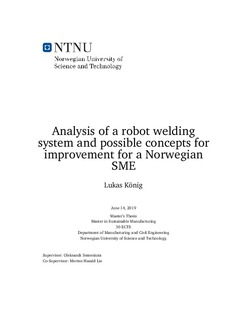| dc.description.abstract | The production of commodities in Norway requires a well designed production system, able to cope
with customer requirements and challenges induced by the economic standards of the country.
Customers require high quality products to be delivered fast that suit exactly the needs of the job
that has to be carried out. Economical challenges in these regards come from the high cost of labor,
which means buying manual labor for the sake of flexibility is not a permanent solution. It can
be used as a measure to increase flexibility and throughput for a limited period, but cannot be
economically feasible permanently.
Tokvam AS is such a company, employing less than 40 people and being located in central Norway.
The products are attachments for tractors and other carrier vehicles for road maintenance
mainly in winter but also in summer conditions. Ranging from snowblowers over salt- and sandspreaders,
snowplows to sweepers, Tokvam can provide a product portfolio to its customers that
covers all the essential tasks when ice and snow (and the residues after the winter season) need
to be removed or treated for traffic to function. The large portfolio requires a production of attachments
in many different sizes and variations, additional equipment and spare parts. To be able
to deliver all those with short lead times, in high quality and for good price while still remaining
competitive requires for that production to be automated where possible.
This thesis follows the analysis of a part of the company’s production system, a welding robot
used for producing smaller machine parts, which is not able to produce up to the varying demand.
Due to long changeover time and problems with the logistics of jigs and fixtures, manual welding is
still the preferred method for some components. Two alternative robot welding systems to replace
that welding cell have been suggested, replacing the cell is one strategy which the author discusses.
Further, during the research the author found flaws in the current organization of welding jigs and
fixtures as being used in the affected robot welding cell. The influence of these factors that lie outside
the welding cell’s system was examined as it offers another concept for improving the weldingand
production system. A third possible alternative, a hybrid work space for manual and robotic
welding, was discovered during the project. In addition to being a way for automated welding of
small-size, large-volume parts this option has the secondary value of introducing a collaborative
human-robot environment using amongst others sensor-assisted teaching. The author discusses the
opportunities and possible drawbacks of this rather low-cost solution.
The thesis concludes with the suggestion to opt for two of the proposed solutions to solve the
current problems: systematically organizing and integrating jigs into the ERP system and investing
in the hybrid welding system. The author discussed the risks and opportunities of all proposed
solutions and these two promise to yield improvements in most of the problematic areas. At the
same time the hybrid system can be a stepping stone for Tokvam to develop further towards human-robot collaborative manufacturing systems. Further, the financial effort connected to implement the
proposed improvements is significantly lower than the one for the other proposed robotic welding
systems. | |
